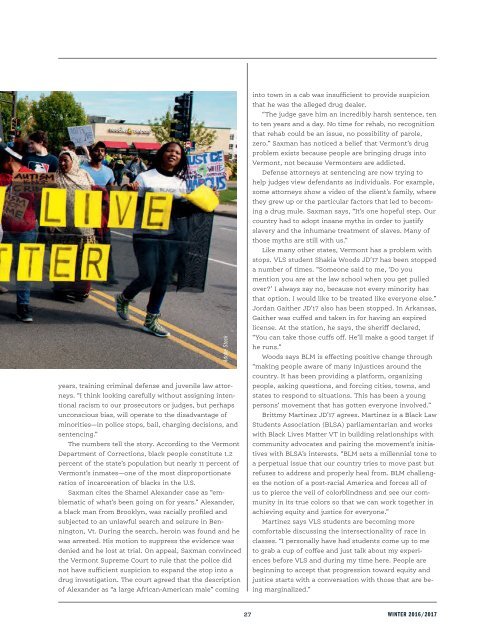In search of justice
fall2016_web
fall2016_web
Create successful ePaper yourself
Turn your PDF publications into a flip-book with our unique Google optimized e-Paper software.
years, training criminal defense and juvenile law attorneys.<br />
“I think looking carefully without assigning intentional<br />
racism to our prosecutors or judges, but perhaps<br />
unconscious bias, will operate to the disadvantage <strong>of</strong><br />
minorities—in police stops, bail, charging decisions, and<br />
sentencing.”<br />
The numbers tell the story. According to the Vermont<br />
Department <strong>of</strong> Corrections, black people constitute 1.2<br />
percent <strong>of</strong> the state’s population but nearly 11 percent <strong>of</strong><br />
Vermont’s inmates—one <strong>of</strong> the most disproportionate<br />
ratios <strong>of</strong> incarceration <strong>of</strong> blacks in the U.S.<br />
Saxman cites the Shamel Alexander case as “emblematic<br />
<strong>of</strong> what’s been going on for years.” Alexander,<br />
a black man from Brooklyn, was racially pr<strong>of</strong>iled and<br />
subjected to an unlawful <strong>search</strong> and seizure in Bennington,<br />
Vt. During the <strong>search</strong>, heroin was found and he<br />
was arrested. His motion to suppress the evidence was<br />
denied and he lost at trial. On appeal, Saxman convinced<br />
the Vermont Supreme Court to rule that the police did<br />
not have sufficient suspicion to expand the stop into a<br />
drug investigation. The court agreed that the description<br />
<strong>of</strong> Alexander as “a large African-American male” coming<br />
Adobe Stock<br />
into town in a cab was insufficient to provide suspicion<br />
that he was the alleged drug dealer.<br />
“The judge gave him an incredibly harsh sentence, ten<br />
to ten years and a day. No time for rehab, no recognition<br />
that rehab could be an issue, no possibility <strong>of</strong> parole,<br />
zero.” Saxman has noticed a belief that Vermont’s drug<br />
problem exists because people are bringing drugs into<br />
Vermont, not because Vermonters are addicted.<br />
Defense attorneys at sentencing are now trying to<br />
help judges view defendants as individuals. For example,<br />
some attorneys show a video <strong>of</strong> the client’s family, where<br />
they grew up or the particular factors that led to becoming<br />
a drug mule. Saxman says, “It’s one hopeful step. Our<br />
country had to adopt insane myths in order to justify<br />
slavery and the inhumane treatment <strong>of</strong> slaves. Many <strong>of</strong><br />
those myths are still with us.”<br />
Like many other states, Vermont has a problem with<br />
stops. VLS student Shakia Woods JD’17 has been stopped<br />
a number <strong>of</strong> times. “Someone said to me, ‘Do you<br />
mention you are at the law school when you get pulled<br />
over?’ I always say no, because not every minority has<br />
that option. I would like to be treated like everyone else.”<br />
Jordan Gaither JD’17 also has been stopped. <strong>In</strong> Arkansas,<br />
Gaither was cuffed and taken in for having an expired<br />
license. At the station, he says, the sheriff declared,<br />
“You can take those cuffs <strong>of</strong>f. He’ll make a good target if<br />
he runs.”<br />
Woods says BLM is effecting positive change through<br />
“making people aware <strong>of</strong> many in<strong>justice</strong>s around the<br />
country. It has been providing a platform, organizing<br />
people, asking questions, and forcing cities, towns, and<br />
states to respond to situations. This has been a young<br />
persons’ movement that has gotten everyone involved.”<br />
Brittmy Martinez JD’17 agrees. Martinez is a Black Law<br />
Students Association (BLSA) parliamentarian and works<br />
with Black Lives Matter VT in building relationships with<br />
community advocates and pairing the movement’s initiatives<br />
with BLSA’s interests. “BLM sets a millennial tone to<br />
a perpetual issue that our country tries to move past but<br />
refuses to address and properly heal from. BLM challenges<br />
the notion <strong>of</strong> a post-racial America and forces all <strong>of</strong><br />
us to pierce the veil <strong>of</strong> colorblindness and see our community<br />
in its true colors so that we can work together in<br />
achieving equity and <strong>justice</strong> for everyone.”<br />
Martinez says VLS students are becoming more<br />
comfortable discussing the intersectionality <strong>of</strong> race in<br />
classes. “I personally have had students come up to me<br />
to grab a cup <strong>of</strong> c<strong>of</strong>fee and just talk about my experiences<br />
before VLS and during my time here. People are<br />
beginning to accept that progression toward equity and<br />
<strong>justice</strong> starts with a conversation with those that are being<br />
marginalized.”<br />
27 WINTER 2016/2017


